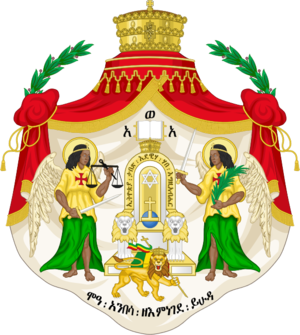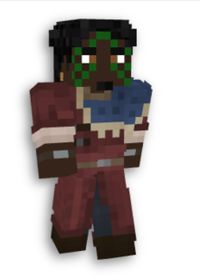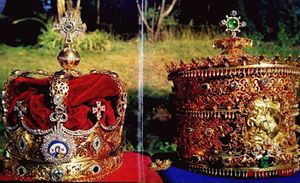Difference between revisions of "Chieftaincy of Ghanyah"
(→Tradition) |
(→Women) |
||
| Line 62: | Line 62: | ||
=== Women === | === Women === | ||
| − | In Ghanyan society, women are seen as graceful and majestic; too graceful to bother themselves with the jobs of Men, they are typically expected to become housewives, cookers, cleaners, gardeners, tailors even. Women who go on to become soldiers, builders, or scholars are typically seen as barbaric or unorthodox. Even the power of women Regnants are challenged due to their sex. At the age of 15, it is accustomed to most tribes for "Kradas" to be held for women, during Kradas women are typically gifted jewelry; it is a party where women are meant to find husbands. Though, it is not uncommon for the justicial system to be more leniant on women who commit crimes. | + | In Ghanyan society, women are seen as graceful and majestic; too graceful to bother themselves with the jobs of Men, they are typically expected to become housewives, cookers, cleaners, gardeners, tailors even. Women who go on to become soldiers, builders, or scholars are typically seen as barbaric or unorthodox. Even the power of women Regnants are challenged due to their sex. At the age of 15, it is accustomed to most tribes for "Kradas" to be held for women, during Kradas women are typically gifted jewelry; it is a party where women are meant to find husbands. Though, it is not uncommon for the justicial system to be more leniant on women who commit crimes. A Ghanyan woman who holds true to her tradition deserves the utmost respect. |
== Artifacts == | == Artifacts == | ||
Revision as of 04:26, 13 July 2018
|
The Chieftaincy of Ghanyah, also known as the Chieftaincy of Southerons, is a nation founded in the Atlasian deserts in 1656. Holding a large mass of the Farfolk populace, the Chieftaincy has become one of the few havens to the subrace; though unlike others, the Ghanyans have held true to their tribal roots with hints of feudalism in its central government. The Southeron people, not to be confused with the Southrons, have found refuge and haven in this desert-based nation.
Contents
National Information
Motto : One is born, One dies; the land grows
National Salute : Fists Together, Head tilted upwards
Language(s): Ghanyan (Broken Common), Ghanwua(Ceremonial and Titular)
Religion(s): Shamanism
Owned Territories: M'Baku, Kharmandal, Yeondar, Khonmahkite, Fort Negus
Officiated Tribes : M'Baku, Yereltai, Khonma
Appearance
Like most Southerons, Ghanyans are typically tall and dark-skinned. They usually wear light or revealing clothing with a large quantity of Jewelry on them, gold being the most common. Due to their militarized and aggressive society, it is not uncommon to find wounds, scars, or other forms of injury littered across Ghanyan men; though they are typically buff or fit. Higher ranked men and women usually have face paintings that sport Ghanyah's national colors; Green, Yellow, Red, and Black. Those descended from slaves usually have brandings on them, many tribes have inducted their old branding marks into the natural symbols of their tribes. They have coarse or curly hair with varied eye colors.
Tradition
In Ghanyan tradition, naturalism is quite important - although magic is allowed, a typical Ghanyan would scowl at a plant that is magically grown by a druid rather than a plant that is grown naturally by a farmer. Fighting is a very big part of Ghanyan culture, although it is unsupported for women to fight physically.
Men
In Ghanyan society, men are the destined leaders. Society expects for them to become warriors, soldiers, even Warlords; making it a shame to be frail or weak as a man.During the reign of Balrogiin Sr, men who were considered weak and frail were given the option of becoming "Magisters", those who refused and were unable to find suitable jobs were forced to become Eunuchs. Men are meant to hunt, procreate, and lead/protect the women and children. At young ages they are drafted as soldiers if necessary, it is a custom in most Ghanyan tribes to hold an Ageni(Uh-jen-yi) for their sons on their 12th birthday, which means "Hunters Fest" in the Ghanwua Language. During an Ageni, men are given their first customary spears and shields; which they then take to "bleed" during their first hunt.
Women
In Ghanyan society, women are seen as graceful and majestic; too graceful to bother themselves with the jobs of Men, they are typically expected to become housewives, cookers, cleaners, gardeners, tailors even. Women who go on to become soldiers, builders, or scholars are typically seen as barbaric or unorthodox. Even the power of women Regnants are challenged due to their sex. At the age of 15, it is accustomed to most tribes for "Kradas" to be held for women, during Kradas women are typically gifted jewelry; it is a party where women are meant to find husbands. Though, it is not uncommon for the justicial system to be more leniant on women who commit crimes. A Ghanyan woman who holds true to her tradition deserves the utmost respect.
Artifacts
Dynastic Crowns
On the left is the Crown of the Itege and on the right is the Crown of the Negus. Arguably the most important Artifacts ever invented in the nation, they are the Crown Jewels of the nation and are only worn for ceremonial reasons.
Language
The language of Ghanyah has been mixed since the times before its creation, the original decadents of M'Baku spoke a newly forgotten language, the language of Ghanwua. Although important words such as titles have been remembered, the domain language has been wholly forgotten. With the large migration of foreigners, intergration of several Farfolk cultures, and the immense influence from the neighbouring Warhawkes and Orcs; the Ghanyan language has become a broken form of the common language, basically a hard to understand language in its own right.
Ghanyan
Language Examples :
Tusky(Tuskies) : Orc(s)
Shawty(Shawties) : Dwarf(ves)
Earee(Earies) : Elf(ves)
Lickleman(Licklemen) : Halfling(s)
Pussi(Pussi-es) : Kha(s)
Whitey(Whities) : Lighter skinned humans
Mon : Man
Omon : Woman
Luk : Look
I : Me
‘Im : He
Shi : She
Wi : We
Dem : They/Them
Unu : You all
Nu : No
Eyah : It
Em : Is
Yuh/Yu : you`
Gu : Go/Going
Tink : Think
Fi : For
Dot : That
De : The
Tideh : Today
Fenkeh : Poor
Chakka : Dirty
Nyami : Greedy
Wha Gwaan : How are you?(What’s going on)
Y Pree : What’s up?
Nuttin Nah Gwan : Nothings going on
Small up yeh self : Move out the way
Mi a go: I’m leaving
Walk Good : Be safe(See you soon)
Brainz : Smart/Intelligent
Pickney : A child
Yute : A teen
Fiyah bun : Denounces someone as wrong
Mi run : I’m going to run
Im run : He’s running
Brudda : Friend
Bredrin/Sistren : Friend
Gally : Girl
Coin(z) : Mina(s)
Mi deh yah : I'm here/I've arrived
Git : Get
Si : See/Look
All way : Every way/ In every way
Spek : Speak
Yah'll : You'll
Lurn : Learn
Stucky : Noble/Stuck up
Teachment : Teacher
Jah : Yes
Men : Mean
Tink right : Know (Ex : I know = I tink right)
Voodoo : Magic
Asure : Ensure/Make sure of
Klep : Clip
Teet : Tight/Good
Queff/Queffin/Queffed : Kill/Killing/Killed
Rememb : Remind / Remember
Yuh stand ? : Understand?
Hol : Hold
I'm : Am
Ghanwua
Negus (Neh-goose): King
Itege(Eye-Tuh-Jay): Queen
Negusa Nagast: Emperor(King of Kings)
Nigiste Negestatt: Empress(Queen of Kings)
Le'ul(Lay-yul) : Prince(Sons of Ruler)
Le'ul Ras : Crown Prince(Male heir apparent)
Le'elt Rasi : Crown Princess(Female heir apparent)
Le'elt(Lay-ealt) : Princess(Daughters of Ruler)
Abeto : Prince(Male members of the Regal dynasty)
Abeto-hoy : Great Prince(Male heir presumptive)
Emebet : Princess(Female members of Regal dynasty)
Emebet-hoy : Great Princess(Female heir presumptive)
Ras : Duke
Rasi : Duchess
Meridazmach : Advising/ Supreme Commander
Dejazmach : Commander
Enderase : Regent
Kantiba : Chancellor
Lore
Before Ghanyah, the desert and neighboring savannah was a post to several displaced southerons and other forms of nomadic groups that were dominantly of Farfolk origin, some considered the desert their homes under the discretion of the orcs - who seldom used the desert and savannah upon their landing in Atlas.
The Southerons are accustomed to the heat, the hottest places usually laying in the south - However on Atlas, the desert was North; which caused many Southeron groups who stuck to their ties to migrate there, some even after enslavement. Those already settled in the deserts were fearful that the new migrants would either show them hostility or would attract unwanted attention from powerful nations. The migrants were afraid that many of them would be captured and enslaved – this lead to the forming of tribes out of fear of aggression.
These tribes were mainly populated with the new influx of Southeron people who settled in temporary huts before moving elsewhere in the desert, only accepting those that were either blood-related to them or were proven trustworthy by their Chiefs. However, some tribes began to claim land – the most historically popular of these settled tribes being the “M’Baku Tribe” who’s land held members of their bloodline, families who were allowed protection by previous Chiefs, and even other tribes; it is undocumented how long they were landed, but there are claims that they were settled there even before the great migration to Atlas.
During this time, they were generally unpopular; their positioning in the Oasis was both resourceful and provided them a major upper hand against all other desert settlers, making them the most powerful independent tribe in the desert and savannah region in the times pre-dating Ghanyah. For a time though, they were peaceful and non-threatening – although they held very strict and peculiar isolationism policies. It was not until Balrogiin Sr. became Chief in 1644 that the tribe began to show their hostility to their neighbors, enslaving those that were not to their liking and claiming lands that they felt would benefit their tribe.
This was successful until their enemies began to band together and eventually formed their own coalition, called “The United Tribes of Ghanwua” in 1646, which successfully defeated the M’Baku tribe on several fronts. Balrogiin was not only fighting external wars, but many inside of the tribe held opposing views about him adverting from their way of life.Risking immediate defeat, Balrogiin fled to Krugmar in a last attempt to secure his rule over the area in 1647 which temporarily ended the reconquest war waged by the UTG, although they didn’t disband.
Offering to convert to and spread Shamanism, adhere to their way of life, and help re-establish Orcish rule in the desert; Balrogiin cemented a lasting deal. Krugmar assisted the M’Baku Tribe in re-establishing power in their base land which was successfully retaken on 9th of Deep Cold, 1649; which led to Balrogiin torturing and executing all those who stood and plotted against him, as well as their immediate families.
With control re-established in M’Baku, Grand Chief Balrogiin Sr and his brother Commander Zerrin declared war on the UTG with Krugmar acting as a co-belligerent, eventually winning on 7th of Sun’s Smile, 1650. With tension rising in his newly claimed land, Balrogiin gave many of the disloyal tribes off as slaves; for even further damage-control, he began to reform the multi-cultural government in 1655, outlawing many religions that contradicted shamanism, taking land from de jure tribes and granting them to those loyal to him during the war, establishing slavery and tight-rope laws in order to scare those under him into submission, and even executing members of his own family.
Later that same year, he was killed before his reformation was complete.He was titled Balrogiin Sr ‘the Greed’ of the Desert and was the basis of a large shift in the land.
His son, Balrogiin Jr of Zpring had inherited after him, officially disbanding the “United Tribes of Ghanwua” and atop it, forming the Chieftaincy of Ghanyah in its place on 2nd of Snow’s Maiden, 1656 with a complete governmental rework with assistance from his advisor Veytin. Balrogiin Jr. was known for being the first ‘Negus’ of Ghanyah, for his controversial attempts to ‘rewrite’ the history of Ghanyah through his creation of the first history books in the tribes, and for easing the strict laws established by his Father; especially his removal of historical Isolationist policies.
After some time with the influx of foreigners, the overall view of Ghanyah had changed – their multi-cultures began to phase into one, creating the newfound broken language of ‘Ghanyan’ which held several influences especially from the Orcs of Krugmar and Elves of the Warhawkes, to the lies written in Balrogiin’ history books, which eventually turned to facts due to the ignorance Foreigners held for the history of the Atlasian desert at the time.
Balrogiin Jr of Zpring died in 1661 with the short reign of 6 years, beginning the reign of Juumane the Imperialist. Juumane ‘the Imperialist’ of M’Baku is well-known by the Ghanyan people as the first Negus who held Imperialistic views at a racial level around the nation, although Ghanyah at the time kept to its tribal ties. He held a strong view that the Farfolk should unify under a banner that actually stood for them rather than allow them to subjugate under more powerful empires.
He sought to dignify and preserve all the various aspects of Farfolk culture by creating seperate cities dedicated to each large cultural group ; the subjugation of Kharmandal was a basis for a Subudai city, the creation of Yeondar served as an Easterner division of trade, and he also desired the neighboring Kadarsi Sultanate to serve as a Rasdom devoted to the Qalasheen; this lead to his famous ‘Rite of Usurpation’ written in 1667 by his Advisor-Regent, Valdun. Propoganda in the Chieftiancy was quite formulated during this time, Valdun ‘the Magister’ of the Oasis was well-known as a previous slave of the Orcish Rex Puknaak’Lak and was often credited as an overseer of the young Juumane.
Juumane, accompanied with his Advisor-Regent Valdun and Advising Commander Kimani began an array of hostilities against the Kadarsi Tribe and Sultanate of Haria; they officially declared war in 1670 with The Kingdom of Nottingham and Warnation of Krugmar called in as co-belligerent allies.
Inheritance Tree
(Agnatic-Cognatic Primogeniture)
Balrogiin II of Zpring
Tribe : M’Baku
Titular Legacy : Negus of Ghanyah, Grand Chief of M’Baku, Tribal Warlord, Challenger of Sands, Defender of the Southeron People
Reign : 1645 -1651(6 yrs)
Juumane ‘the Imperialist’ of M’Baku
Tribe : M’Baku
Titular Legacy : Negus of Ghanyah, Grand Chief of M’Baku, Ras of Yeondar, Tribal Warlord, Challenger of Sands, Protector of the Farfolk
Reign : 1651-


